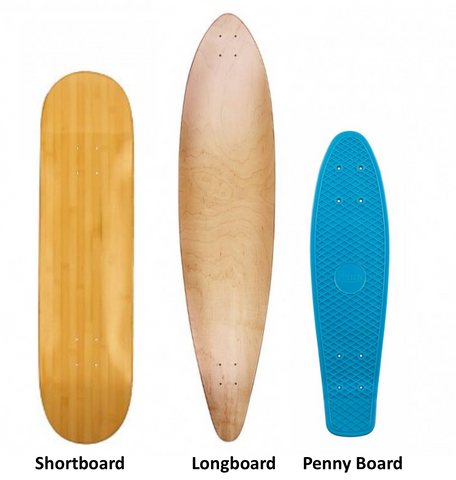The Scoop on Selecting A Skateboard

If you’re looking to buy a skateboard for yourself or as a gift, here’s a guide to the basics. If you don’t know what ABEC means, read on because this article is for you!
This article is designed for new skaters looking to buy their first board or adults buying a skateboard as a gift for kids. We know the sheer number of options can seem daunting, so here’s what you need to know before you get to the store:
Type of Skating
First off, decide what type of skating you’ll be doing. Do you dream of cruising down the beach boardwalk, or know you’ll be using your board as transportation? You’ll want a longboard or a penny board. If you’d like to do some sweet tricks at the skate park, a shortboard is for you. For a first board, we’d recommend a shortboard, because you can do tricks and still cruise with a shortboard, but a longboard is too heavy and bulky to perform tricks.
Still wondering? The type of competitive skateboarding you see on TV, like at the X Games, uses shortboards. The terms “street skateboarding” and “vert skateboarding” also refer to shortboard skating. If the board leaves the ground, that’s a shortboard.
Size and Shape
There are 3 main types of skateboards: longboards, shortboards, and penny boards. Here are some rules of thumb: If the deck is plastic, that’s a penny board. “Penny” is a brand name, but it’s also become the universal term for a plastic boards designed for cruising. If the front (nose) and back (tail) of the board are symmetrical and the edges of the wheels are rounded, that’s a shortboard. If the board is larger than average, the nose and tail are not the same shape, and/or the edges of the wheels are flat, it’s usually a longboard.
Here’s a graphic to show you the differences in shape:

After you decide on a shape, you’ll need the right size. Surprisingly, width determines the size of a skateboard, not length. The width of an average board is 7.5 to 8 inches. Height, weight, shoe size, the type of skating you’d like to do and personal preference are all factors in choosing the right width, but to keep things simple, use this handy skateboard sizer (click the blue “what size” button).
Check for Quality
Trust us, it’s much easier for beginners to skate on a good quality board. The wheels will roll easier, it will be more stable, and it will be easier to turn (that’s a good thing!). Set yourself up for success by inspecting the board for quality in the store. As an easy rule of thumb, you’re checking for the amount of plastic. More plastic = bad.
Here’s what you’re looking for:
- The trucks connect the wheels to the deck. If the trucks are plastic, that’s a bad sign.
- Pass on plastic or rubber wheels. Wheels should be made of urethane (often a whitish clear color), which provide a smoother ride and better grip. Ask a salesman if you’re not sure.
- Spin the wheels. Do they spin freely, without any grinding or wobbling? ABEC is a scale of the preciseness of a bearing. You want ABEC 5 or 7 for skating.
This guide to avoiding cheap skateboards will give you more information about how to test a board for quality. We can’t understate the importance of picking a high quality board for newer skaters.
Where to Buy
If you’re not familiar with skateboarding, you’ll want to visit a local skate shop. Even though they’re often a little more expensive than a big box retailer, skaters swear by them because they offer quality products, insider knowledge, and personalized service. Ask an employee to help you pick out a board, and then use this guide to check for reasonable quality and price. You can be assured that most boards at a dedicated skate shop will be of reasonably high quality. As a bonus, you can also ask the salesperson about local places to skate. If you’re spending upwards of $50 on a new board, don’t be afraid to ask him or her to throw in some free extras like skate wax or skate stickers.
While low prices at big box stores might be tempting, beware that they often sell low-quality boards that can ruin your early skating experience. In addition, the employees likely won’t have the same skating expertise as those at skate shops, so you’ll miss out on the local knowledge, free goodies, and step by step guidance. Don’t order a skateboard online, because you won’t be able to do the super-important quality inspection that we discussed earlier.
Price
Warning: Don’t cheap out. When you walk into the shop, tell them you want a “complete.” That magic word indicates a pre-assembled skateboard that includes all components. Otherwise, you’ll be left to select the deck, trucks, wheels, bearings, hardware, grip tape, and riser pads separately. A complete will often cost slightly more than building your own custom skateboard, but it will save you time and trouble by greatly reducing the number of decisions you’ll have to make in the store. Once you’re more experienced and have learned about your personal preferences you can switch to a new custom board.
In general, here’s what you can expect to pay for a complete skateboard at a skate shop:
Shortboard: $49.99 - $99.99
Longboard: $99.99 - $149.99
Penny Board/Plastic Cruiser: $89.99 - $124.99
If you’d like more advice about choosing a skateboard, check out these 5 Things NOT To Do. Keep in mind that the ‘perfect’ board is really a matter of personal preference, so comment below to let us know about your favorites!
